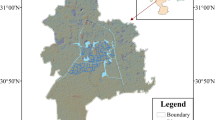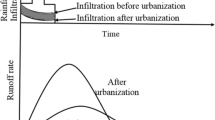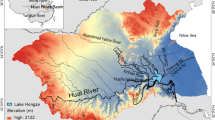Abstract
With the development of the city, people pay more attention to the ecological construction of the city. The objective of this work was to study the effect of artificial lakes on hydrodynamic conditions in urban drainage systems. With Arcgis and the advantage of SWMM in analyzing the impact of the rainfall process on urban runoff, the urban flooding model of “pipe network + river network + artificial lake” was established in the study area. Two scenarios were set up with and without the presence of artificial lakes, and comparative analyses were conducted under the different intensities of rainfall (0.5a, 1a, 2a, 5a, 10a, 20a). The results show that under certain rainfall conditions, the presence of the artificial lake increases the peak flow and rate of upstream streams and decreases the flow and rate of downstream streams in the regional drainage system. The duration of the peak flow rate in the upstream channel increases, and the flow rate curve becomes flat during the confluence; the flow rate in the downstream section decreases, and the magnitude of the peak flow rate change decreases, and a more obvious horizontal section appears. The time of peak occurrence in the downstream river is earlier. The hydrodynamic impact on the downstream channel is more significant. The improvement of hydrodynamic conditions of the drainage system by the artificial lake helps to optimize the layout of low impact development (LID) measures in the study area and also guides ecological construction in other cities.












Similar content being viewed by others
Data availability
Data and materials are available from the corresponding author upon request.
References
Chan Faith Ka S, Chen Wendy Y, Gu XB, Peng Y, Sang YF (2021) Transformation towards resilient sponge cities in China. Nat Rev Earth Environ 3(2): 99–101
Chen P, Zhao JW (2022) Analysis of the origin of urban stormwater flooding disasters and countermeasures. Disaster Sci 37(03):33–36+60
Emerson CH, Welty C, Traver RG (2006) Watershed-Scale Evaluation of a System of Storm Water Detention Basins. J Hydrol Eng 10(3):637–637
Fan YY, Wang CW, Yu HY (2019) Research on SWMM model river and open full flow simulation capability analysis. J Water Resour Water Eng 30(01):1–6
Han YJ, Wu ZN, Guo YY, Hu YX (2022) A comparative study of rain type and urban catastrophic precipitation in Chicago. People’s Changjiang 53(05):35–40+52
Hou JM, Han H, Qi WC, Guo KH, Li ZB (2019) Experimental investigation for impacts of rain storms and terrain slopes on low impact development effect in an idealized urban catchment. J Hydrol 579:24176
Huang C, Zhang XX, Wi H, Liu CJ (2022) Urban rainfall and flood control scenario simulation based on SWMM model and GIS technology–take Zhenjiang urban area as an example. People’s Changjiang 53(04):31–36
Jiang FR, Jiang B (2012) Analysis of the impact of the “7-21” heavy rainstorm in Beijing and its countermeasures. China Water Resour 15:4
Liang L, Guo Z, Yang H, Zhang H, Huang W (2020) Ecological response characteristics of interconnected river system network in Karst Area: a case study of Dabang River basin connecting engineering in Guizhou Province. In: E3S Web of Conferences, 165:01015. EDP Sciences
Liaw CH, Tsai YL, Cheng MS (2006) Assessing flood mitigation alternatives in Shijr area in metropolitan. J Am Water Resour Assoc 42(2):311–322
Liu ZZ, Song YX, Ye RQ (2021) Remote sensing interpretation and analysis of the 2014 “8-31” rainstorm-induced landslide in northeastern Chongqing. Remote Sens Nat Resour 33(4):8
Lucie W, Christa K, Cliff D (2021) Investigating model performance and parameter sensitivity for runoff simulation across multiple events for a large green roof. Hydrol Process 35(10):e14387
Ma MH, Li JK, Chen N (2017) Simulation analysis of urban flooding and surface source pollution based on SWMM model. J Hydropower 36(11):62–72
Mascarenhas FCB, Miguez MG, Magalhães LPCD (2006) On-site stormwater detention as an alternative flood control measure in ultra-urban environments in developing countries. IAHS AISH Publ 17(4):538–542
Naren MDR, Gong LX, Zhang HG, Chun F, Guo EL (2022) Analysis of spatial and temporal distribution characteristics of urban flooding and its causes–Hohhot city area as an example. Disaster Sci 37(01):107–111
Pachaly Robson L, Vasconcelos José G, Allasia Daniel G, Bocchi João Pedro (2022) Evaluating SWMM capabilities to simulate closed pipe transients. J Hydraul Res 60(1):74–81
Qi WC, Hou JM, Liu JH (2018) Simulation study on the role of urban lakes in controlling surface runoff causing flooding. Journal of Hydropower 37(09):8–18
Qi XT, Zhang ZM (2022) Assessing the urban road waterlogging risk to propose relative mitigation measures. Sci Total Environ 849:157691
Qi WC (2019) Simulation study on the effect of runoff storage facilities on flood control. Xi’an University of Technology
Qiu BR, Sang XF, Zhou ZH (2018) Analysis of the regulating role of lakes in Ezhou City. China Rural Water Conservancy and Hydropower 06:44–48
Ran XQ, Li YS, Zhuo H (2020) Research on rainwater flood control scheme for roads in sponge cities based on SWMM model. China Rural Water Conservancy and Hydropower 2:40–43, 47
SangSoo B, Mayzonee L, Yakov P, Jong AC (2020) Assessment of a green roof practice using the coupled SWMM and HYDRUS models. J Environ Manag 261:109920
Wang J, Liu JH, Wang H (2020) Matching analysis of investment structure and urban inundation control function of sponge cities in China. J Clean Prod 266:121850
Wang YT, Liu Z, Wang GQ, Xue WC (2021) Cellular automata based framework for evaluating mitigation strategies of sponge city. Sci Total Environ 796:148991
Wang FF, Qing XX, Yang SX, Cui ZJ (2022a) Research on automatic rate determination of SWMM parameters based on PySWMM. China Water Supply Drainage. 38(21):124–13. https://doi.org/10.19853/j.zgjsps.1000-4602.2022.21.018
Wang J, Xu WP, Ma FK (2022b) Reflections and suggestions on urban lake management. People’s Yangtze River. 53(02):41–47+71
Wang LY, Li Y, Hou H, Chen Y, Fan JJ, Wang P, Hu TG (2022c) Analyzing spatial variance of urban waterlogging disaster at multiple scales based on a hydrological and hydrodynamic model. Nat Hazards 114(2):1915–1938
Wilson CE, Hunt WF, Winston RJ et al (2015) Comparison of runoff quality and quantity from a commercial low-impact and conventional development in Raleigh, North Carolina. J Environ Eng 141(2):05014005
Xia J, Zhang Y, Liang CM (2018) A review of urban rainfall flood modeling research. Wuhan Univ: Engineering Edition 51(2):11
Xia J, Zhang YY, Xiong LH (2017) Opportunities and challenges of the sponge city construction related to urban water issues in China. Sci China Earth Sci 60(4)
Yang LH, Li JZ, Kang AQ, Li S, Feng P (2020) The effect of nonstationarity in rainfall on urban flooding based on coupling SWMM and MIKE21. Water Resour Manag 34:1535–1551
Yang YY, Li J, Huang Q, Xia J, Li JK, Liu DF, Tan QT (2021) Performance assessment of sponge city infrastructure on stormwater outflows using isochrone and SWMM models. J Hydrol 597:126–151
Yu MY, Zhao ZW (2020) Overview of water environmental protection research in urban artificial lakes. Water Resour Hydropower Express 41(06):25–32
Zang JL, Guo QZ, Sang X, Xie TL, He CW (2020) Spatio-temporal variation coupling relationship of lake - inundation in the coastal city of Tianjin. J Remote Sens 24(02):199–213
Zhang JY, Wang YT, He RM et al (2016) Analysis of urban flooding problems and causes in China. Adv Water Sci 27(4):7
Zhang JY, Wang YT, Liu CS (2017) Discussion on urban flooding and prevention and control criteria in China. J Hydropower 36(1):1–6
Zhang Q, Chen SE, Cai SB (2018) Simulation study on the joint operation of LID measures and rainwater storage ponds. China Water Supply and Drainage. 34(09):134–138. https://doi.org/10.19853/j.zgjsps.1000-4602.2018.09.027
Zhang C, Li R, Dai L (2021a) Restoration of urban water environment landscape system and SWMM technology integration in water-scarce cities. Iranian J Sci Technol – Trans Civil Eng 12:1–8
Zhang XQ, Wang K, Wang Tao. (2021b) SWMM-based assessment of the improvement of hydrodynamic conditions of urban water system connectivity. Water Resour Manag 35(13):4519–4534
Zhao DW, Chen TO, Han HZ (2021) The connotation and application of non-engineering measures for LID in sponge cities. China Water Supply and Drainage 37(22):31–37. https://doi.org/10.19853/j.zgjsps.1000-4602.2021.22.005
Zheng XY, Zhang WS, Xu GH et al (2016) (2016) Study on the impact of heavy rainfall on the hydrodynamics and water quality of Liangzi Lake. People’s Yangtze River 47(9):17–21
Zhong X (2022) Investigation report on the “7-20” heavy rainstorm disaster in Zhengzhou. Saf Prod Supervision 2:2
Zhou H, Liu J, Gao C (2018) Analysis of the current situation and problems of urban waterlogging prevention and control in China. Disaster Sci 33(03):147–151
Author information
Authors and Affiliations
Contributions
All authors contributed to the study’s conception and design. writing and editing: Xianqi Zhang and Wenbao Qiao; chart editing: Minghui Zhang; preliminary data collection: Haiyang Chen and Yihao Wen. All authors read and approved the final manuscript.
Corresponding author
Ethics declarations
Ethics approval and consent to participate
Not applicable.
Consent to participate
Not applicable.
Consent for publication
All authors agree to publish.
Conflict of interests
The authors declare no competing interests.
Additional information
Responsible Editor: Philippe Garrigues
Publisher's note
Springer Nature remains neutral with regard to jurisdictional claims in published maps and institutional affiliations.
Rights and permissions
Springer Nature or its licensor (e.g. a society or other partner) holds exclusive rights to this article under a publishing agreement with the author(s) or other rightsholder(s); author self-archiving of the accepted manuscript version of this article is solely governed by the terms of such publishing agreement and applicable law.
About this article
Cite this article
Zhang, X., Qiao, W., Zhang, M. et al. Improvement and evaluation of hydrodynamic conditions in plain regional drainage systems by artificial lakes: a case study of Xinxiang Economic Development Zone, China. Environ Sci Pollut Res 30, 77642–77656 (2023). https://doi.org/10.1007/s11356-023-27786-5
Received:
Accepted:
Published:
Issue Date:
DOI: https://doi.org/10.1007/s11356-023-27786-5




